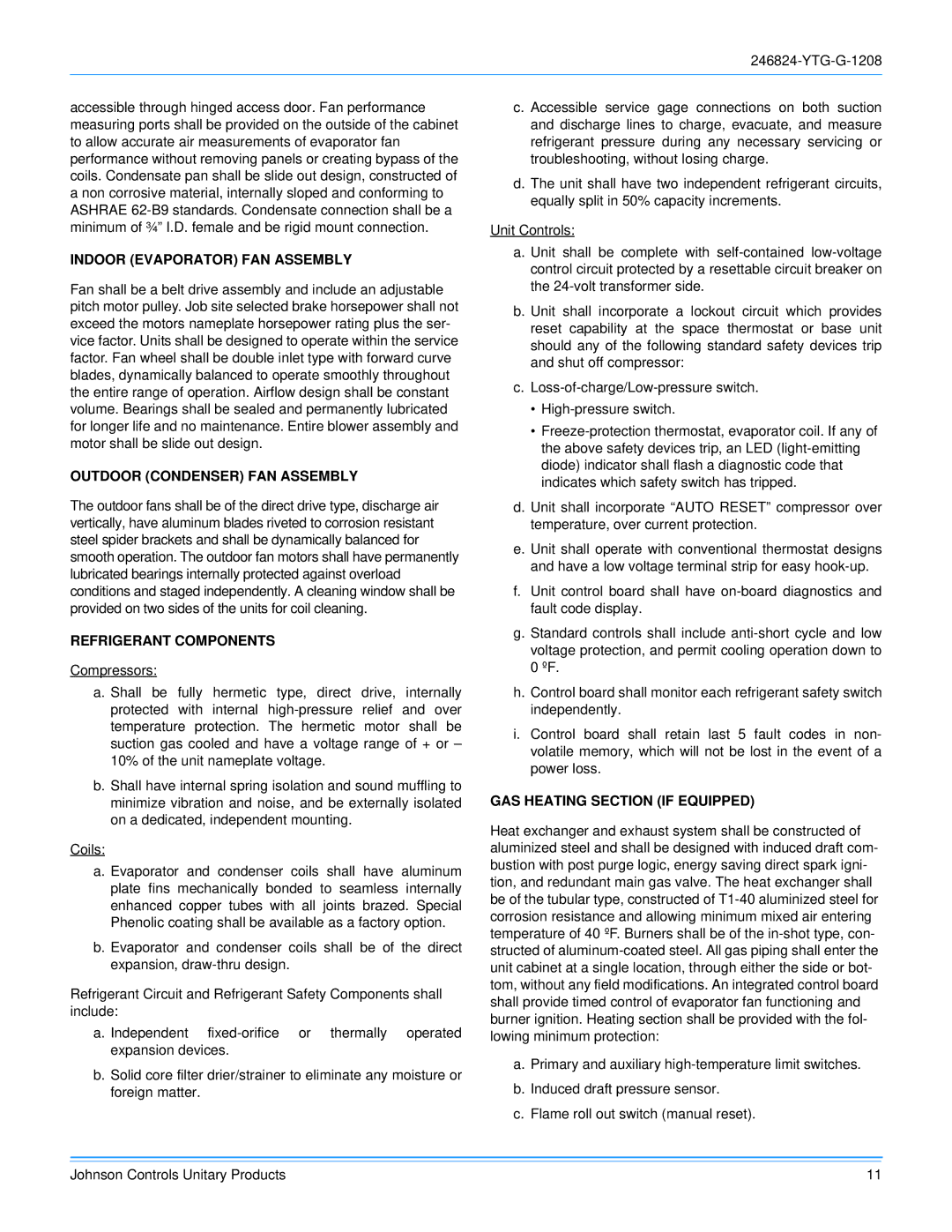accessible through hinged access door. Fan performance measuring ports shall be provided on the outside of the cabinet to allow accurate air measurements of evaporator fan performance without removing panels or creating bypass of the coils. Condensate pan shall be slide out design, constructed of a non corrosive material, internally sloped and conforming to ASHRAE 62-B9 standards. Condensate connection shall be a minimum of ¾” I.D. female and be rigid mount connection.
INDOOR (EVAPORATOR) FAN ASSEMBLY
Fan shall be a belt drive assembly and include an adjustable pitch motor pulley. Job site selected brake horsepower shall not exceed the motors nameplate horsepower rating plus the ser- vice factor. Units shall be designed to operate within the service factor. Fan wheel shall be double inlet type with forward curve blades, dynamically balanced to operate smoothly throughout the entire range of operation. Airflow design shall be constant volume. Bearings shall be sealed and permanently lubricated for longer life and no maintenance. Entire blower assembly and motor shall be slide out design.
OUTDOOR (CONDENSER) FAN ASSEMBLY
The outdoor fans shall be of the direct drive type, discharge air vertically, have aluminum blades riveted to corrosion resistant steel spider brackets and shall be dynamically balanced for smooth operation. The outdoor fan motors shall have permanently lubricated bearings internally protected against overload conditions and staged independently. A cleaning window shall be provided on two sides of the units for coil cleaning.
REFRIGERANT COMPONENTS
Compressors:
a. Shall be fully hermetic type, direct drive, internally protected with internal high-pressure relief and over temperature protection. The hermetic motor shall be suction gas cooled and have a voltage range of + or – 10% of the unit nameplate voltage.
b.Shall have internal spring isolation and sound muffling to minimize vibration and noise, and be externally isolated on a dedicated, independent mounting.
Coils:
a. Evaporator and condenser coils shall have aluminum plate fins mechanically bonded to seamless internally enhanced copper tubes with all joints brazed. Special Phenolic coating shall be available as a factory option.
b. Evaporator and condenser coils shall be of the direct expansion, draw-thru design.
Refrigerant Circuit and Refrigerant Safety Components shall include:
a. Independent fixed-orifice or thermally operated expansion devices.
b.Solid core filter drier/strainer to eliminate any moisture or foreign matter.
c. Accessible service gage connections on both suction and discharge lines to charge, evacuate, and measure refrigerant pressure during any necessary servicing or troubleshooting, without losing charge.
d. The unit shall have two independent refrigerant circuits, equally split in 50% capacity increments.
Unit Controls:
a. Unit shall be complete with self-contained low-voltage control circuit protected by a resettable circuit breaker on the 24-volt transformer side.
b. Unit shall incorporate a lockout circuit which provides reset capability at the space thermostat or base unit should any of the following standard safety devices trip and shut off compressor:
c.Loss-of-charge/Low-pressure switch.
•High-pressure switch.
•Freeze-protection thermostat, evaporator coil. If any of the above safety devices trip, an LED (light-emitting diode) indicator shall flash a diagnostic code that indicates which safety switch has tripped.
d.Unit shall incorporate “AUTO RESET” compressor over temperature, over current protection.
e.Unit shall operate with conventional thermostat designs and have a low voltage terminal strip for easy hook-up.
f.Unit control board shall have on-board diagnostics and fault code display.
g.Standard controls shall include anti-short cycle and low voltage protection, and permit cooling operation down to 0 ºF.
h.Control board shall monitor each refrigerant safety switch independently.
i.Control board shall retain last 5 fault codes in non- volatile memory, which will not be lost in the event of a power loss.
GAS HEATING SECTION (IF EQUIPPED)
Heat exchanger and exhaust system shall be constructed of aluminized steel and shall be designed with induced draft com- bustion with post purge logic, energy saving direct spark igni- tion, and redundant main gas valve. The heat exchanger shall be of the tubular type, constructed of T1-40 aluminized steel for corrosion resistance and allowing minimum mixed air entering temperature of 40 ºF. Burners shall be of the in-shot type, con- structed of aluminum-coated steel. All gas piping shall enter the unit cabinet at a single location, through either the side or bot- tom, without any field modifications. An integrated control board shall provide timed control of evaporator fan functioning and burner ignition. Heating section shall be provided with the fol- lowing minimum protection:
a.Primary and auxiliary high-temperature limit switches.
b.Induced draft pressure sensor.
c.Flame roll out switch (manual reset).

